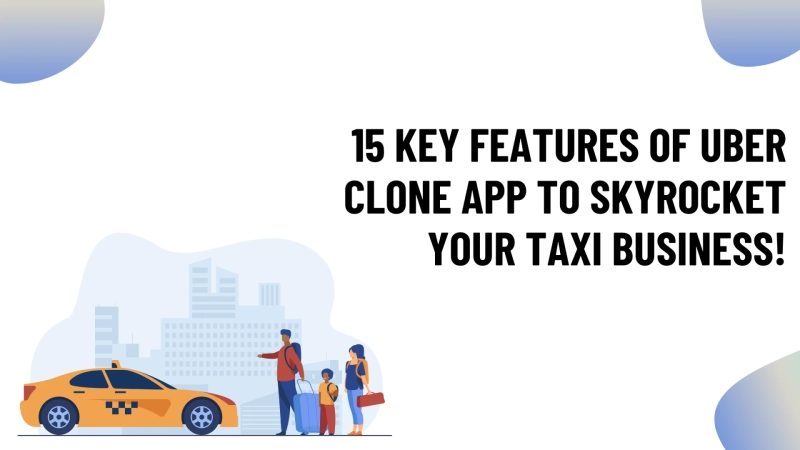Owning an on-demand taxi business entails more than just business models and a profit system. It is all about giving your customers what they want in order to grow and strengthen your business.
Using the right features and functionalities for your Uber clone app and constantly updating them to meet the changing needs of your customers will help your taxi business run more smoothly.
This article will look at 15 unique Uber clone app features that you should consider to meet market standards and expectations.
Let's get started right away to learn more!
What exactly is an Uber clone app?
Uber's business model has been extremely successful, and the company has been a pioneer in on-demand services. As a result, entrepreneurs who want to start an on-demand business want this business model for themselves.
That is how the Uber clone app came into play. Uber clone is a ready-made solution for entrepreneurs that can be customized and white-labeled to meet their specific business requirements.
The Uber clone app connects people who need a product or service with those who are willing to provide it, and you will be responsible for maintaining the on-demand marketplace that connects these two.
15 Key features of the Uber clone app that you should be aware of:
There are three types of people who should be satisfied with the on-demand platform: riders, drivers, and yourself (the admin). All of these features are required to run your business smoothly!
Rider features:
1. Fare Estimation:
Once the rider enters the pickup and drop-off location, an estimated ride fare for each vehicle category will be displayed.
Riders can then select an option based on their budget. After the ride is over, the bill will include a detailed fare breakdown.
2. Wallet option:
Riders no longer need to leave the app to make payments. They can pay for the ride with their wallet. If the wallet runs out of money, riders can replenish it by entering their debit or credit card information. We encourage cashless transactions!
3. In-app chatting:
Riders can communicate with drivers through the in-app chatting feature. After making the reservation, the riders will receive the driver's information, which includes the driver's name, vehicle number, and a chatbox icon. Riders can communicate with the driver by clicking on the chatbox icon.
4. Ride scheduling:
Riders can now plan their rides for the near future. All the rider has to do is "Schedule the ride" by providing a specific date and time that works for them.
5. SOS assistance:
Riders can enter their emergency contact information into their Uber clone app. 911 and the riders' emergency contacts are included in the contact information.
An SMS with the vehicle number and current location will be automatically sent to the SOS contact.
6. Stripe 3D security:
Integrating safer payment gateways increases app user trust and encourages cashless transactions.
Driver features:
1. Dynamic routing:
The dynamic routing feature of the Uber clone app allows the driver to reach the drop-off location faster on the map. It will show them the shortest routes available.
2. Payout account:
A payout account allows drivers to receive a portion of their earnings from the admin/business owner. They should be able to enter multiple account details.
3. Earnings report dashboard:
The earnings report dashboard allows drivers to keep track of their weekly and total earnings. This report may include information about the number of completed rides in a week and overall.
4. RTL support:
Drivers can use the driver's app in their preferred language. There could also be RTL (right to left language) support to assist them in selecting RTL languages such as Arabic.
5. Driver status:
Using an online/offline toggle, drivers can change their activity status. This allows the app algorithm to determine whether or not the driver is available to accept a ride.
Admin panel features:
1. Geofencing:
Geofencing allows administrators/business owners to manage their on-demand taxi business within a specific geographic area. The admin can mark the map area where the platform will operate. Based on these locations, the admin can also set ride fares.
2. Management of sub-admins:
The admin's work can be simplified by delegating responsibilities to sub-admins. Using this feature, administrators can assign roles and responsibilities to sub-admins.
3. Auto-payout:
Imagine manually calculating and distributing earnings to hundreds of thousands of drivers! Isn't it difficult?
This is where the automatic payout feature comes in handy.
The Uber clone app's auto payout feature has made it easier for administrators to manage the financial aspects of the business more efficiently.
The auto-payout feature distributes earnings automatically.
4. User and booking management:
The administrator can manage the users [riders and drivers] as well as the bookings made by the riders. This procedure ensures that only legitimate users access and use the platform.
Users and booking management features also assist the administrator in overseeing the entire ride details and earnings management.
Conclusion
To be the best in the market, it is essential to meet certain requirements when it comes to running a smooth business using advanced technologies.
It is not difficult to integrate an app into a business. The app's user-friendliness and customer satisfaction are the top priorities.
Get to know Wooberly - Uber Clone App, our exclusive on-demand marketplace that is 100% customizable and scalable.
0


